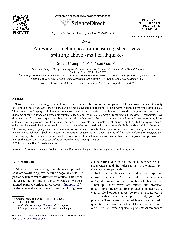摘要
Seismic shear-wave splitting is difficult to measure accurately because of the complexity of the shear-wave signal. A variety of techniques have been developed for measuring time-delays and polarisations of shear-wave splitting above small earthquakes. These range from 'display' techniques, where measurements depend on visual examination of rotated seismograms and polarisation diagrams, through a range of increasingly automatic techniques, to what are almost fully automatic processes. All techniques have disadvantages. Visual techniques are subjective and, although arguably the most accurate, are tedious and time-consuming. More automated techniques work well on noise-free impulsive near-classic examples of shear-wave splitting, but on typical records either require visual checking or need to pass stringent selection criteria which may severely limit the data and bias the results. The accompanying paper presents a combination of visual and automatic techniques to provide a user-friendly semi-automatic measurement technique. Such techniques are important because the new understanding of fluid-rock deformation suggests that shear-wave splitting monitors the low-level deformation of fluid-saturated microcracks in hydrocarbon production processes, as well as the accumulation of stress before earthquakes, and other applications.
- 出版日期2006-11
- 单位中国地震局地震预测研究所
